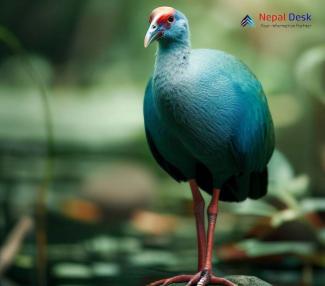The captivating Grey-headed Swamphen (Porphyrio poliocephalus) is a bird species that boasts an eye-catching appearance and intriguing habits. They are natives of South Asia, the Middle East, and Southeast Asia, dwelling in wetland ecosystems. In this article, we'll explore the taxonomy, physical attributes, habitat preferences, and diet of these fascinating birds. We will also delve into their presence within Nepal and reveal an interesting fact about these charming creatures.
Taxonomy
The Grey-headed Swamphen is part of the Rallidae family and Porphyrio genus, making it a relative of other well-known rails like coots and gallinules. This relationship is evident by their physical resemblances and common habitat choices.
Physical Features
The Grey-headed Swamphen's unique appearance is marked by its distinct features and vivid colors. Their grey head and neck blend harmoniously with their rich purple-blue body, while their red frontal shield (the patch above their beak) adds additional color to their striking appearance. The birds have long legs that help them maneuver through wetlands effortlessly. Males are slightly larger than females but both genders exhibit similar physical traits.
Habitat
These birds are quintessential wetland inhabitants – thriving in marshes, swamps, lake edges, and even rice fields. They prefer shallow bodies of water with plenty of vegetation for nesting purposes. Surrounded by reeds and grasses, they can easily hide from predators or human disturbances while searching for sustenance.
Diet
Grey-headed Swamphens are adaptable eaters that consume both plant and animal matter. Their varied diet includes aquatic plants, seeds, bugs, fish, and small amphibians. With their powerful legs and toes adapted to wetland environments, they can efficiently forage for hidden food in the water or mud.
Nepal's Swamphen Population
Nepal boasts a diverse range of bird species, including the Grey-headed Swamphen. The bird's population in Nepal has been steadily increasing to the delight of birdwatchers and conservationists alike. They can be observed in places such as the Koshi Tappu Wildlife Reserve and Chitwan National Park, further enriching the nation's already extensive wildlife.
A Fascinating Aspect:
One remarkable characteristic of the Grey-headed Swamphens is their use of body postures to communicate with their flock. Raising their tail serves as an alarm signal or a territorial display. Additionally, these birds engage in vocal communication through an array of sounds that range from low grunts to high-pitched whistles.
In conclusion, Grey-headed Swamphens provide an exciting subject for nature lovers, bird watchers, and ecotourists alike. Their presence in Nepal sheds light on the region's incredible biodiversity and emphasizes the importance of preserving and protecting vital wetland habitats to ensure the survival of such unique creatures.




